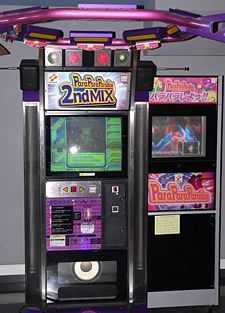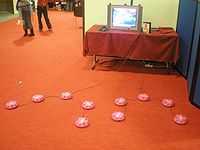Para Para Paradise
| ParaParaParadise | |
|---|---|
 | |
| Developer(s) | Konami Computer Entertainment Japan |
| Publisher(s) | Konami |
| Series | Bemani |
| Platform(s) | Arcade, PlayStation 2 |
| Release date(s) | 2000 |
| Genre(s) | Rhythm, Music, Exercise |
| Mode(s) | Single player, Two Player |
| Cabinet | Unique design |
| Arcade system | Firebeat |
| Display | Raster, standard resolution, horizontal |
ParaParaParadise (パラパラパラダイス Para Para Paradaisu), often abbreviated PPP or Para Para, is an arcade and PlayStation 2 dance game made by the Japanese company Konami and released under the Bemani moniker following the booming Para Para fad.
Konami would later release Dance Evolution for the Xbox 360, game that shares many similarities with "Para Para Paradise". In fact, the game includes several songs with Para Para routines (on specific difficulties).
Gameplay

The gameplay of PPP is very similar to other Konami music games. The cabinet utilizes an octagonal platform with motion detecting sensors above it. Players must trigger the sensors by moving their arms (or other body parts) under the sensors when a corresponding arrow reaches. There are 2 modes, ParaPara Mode, which guides the arrows through an actual routine for the song, and Freestyle Mode, which utilizes more DDR-like patterns with 3 difficulty options, "Normal", "Hard", and "Expert".
The home PlayStation 2 version features a USB peripheral, which has five pink "pods" each with three infrared sensors. Each pod can be individually calibrated to accommodate the height of the players arms.
In the arcade versions, there are colorful backgrounds that play during the song. 2nd Mix introduced the use of CG dancing models in order to teach players the dance routines for the songs (if in ParaPara mode) and danced in the background (also available in Freestyle Mode). A separate cart with a DVD player and a television that played the videos of dances performed by the ParaPara Allstars was also available for 1st Mix v. 1.1. and 2nd Mix. The home edition of ParaParaParadise did not include the CG models but contained the ParaPara Allstar videos as an option for the background.
Music
The music used in Para Para Paradise is exclusively fast-paced Eurobeat. The majority of tracks are "true" Para Para tracks from the Avex Trax record label, such as Velfarre 2000, Anniversary and Boom Boom Fire. A portion of the songs are Eurobeat remixes of other Bemani tracks such as CAN'T STOP FALLIN' IN LOVE. There are also two songs that are J-EURO remixes, remixes of J-pop songs (Aishiattemasu and Deluxe, both by Key-A-Kiss).
Korean version
A Korean version of ParaParaParadise, called ParaParaDancing was also released. The songlist was changed to feature more Korean music, including a remix of BoA's "Sara" and S.E.S.. Songs by Korean artists, H.O.T. "Hold On Me", sung in Korean, was originally in Japanese. ParaParaDancing also features the ability to play on the reverse side of the stage by setting the machine to sense on the rear 5 out of the total 8 sensors, facing the spectators instead.
Emulation and simulation
The developers of MAME have been working on a way to emulate the arcade machine on a computer.
| “ | I've been working on a Konami FireBeat driver for a while now. The hardware is a relatively simple set of stuff. There's currently only one game, Para Para Paradise, dumped. Currently it passes most of its bootup tests (except the RTC/backup RAM test). The test menu is also accessible, but cannot be operated since I haven't found the input ports yet. | ” |
Since then, 14 other FireBeat games have been dumped, although they still remain marked as not working in MAME. The open-source music game StepMania also has support for ParaParaParadise, and CVS versions of version 4.0 support the PS2 version's controller, although actual simfiles for the game are few.
Reception
On release, Famitsu magazine scored the PlayStation 2 version of the game a 31 out of 40.[1]
References
- ↑ プレイステーション2 - パラパラパラダイス. Weekly Famitsu. No.915 Pt.2. Pg.87. 30 June 2006.
| ||||||||||||||||||